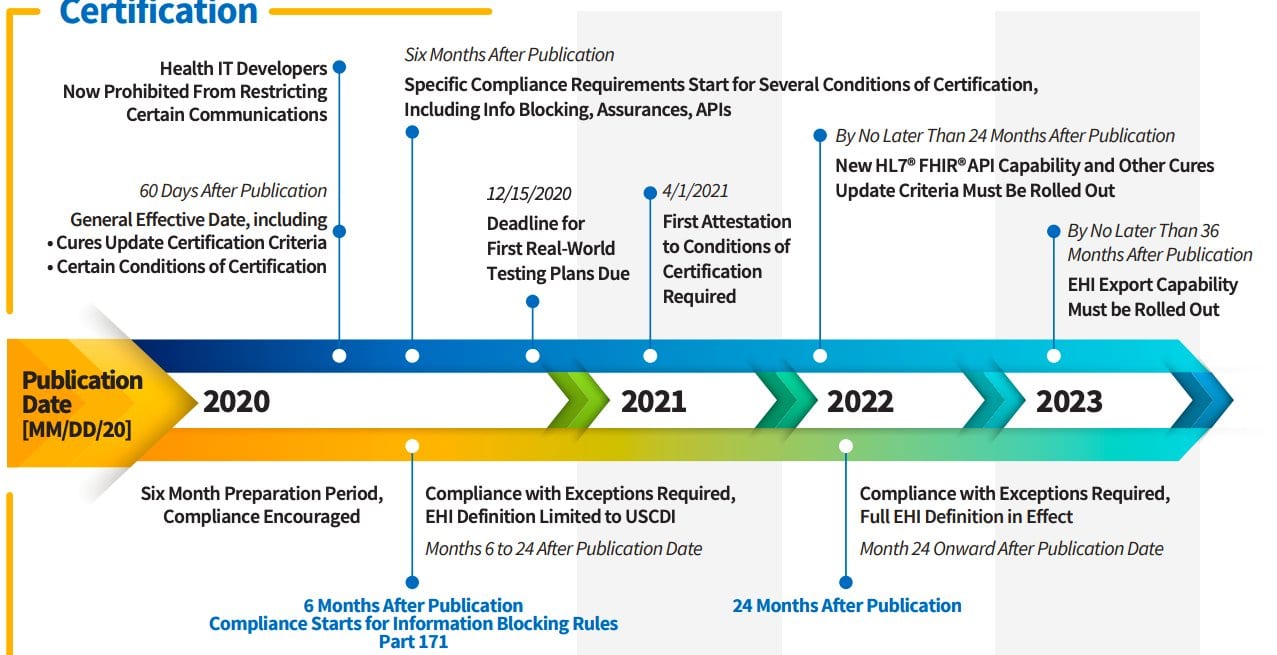Getting to Know the Information Blocking. This rule was designed to give patients greater control over their personal health data and make it easier to share patient records between organizations and with patients.
 Hhs Releases The Information Blocking And Interoperability Final Rule 21st Century Cures Act Healthcare It Today
Hhs Releases The Information Blocking And Interoperability Final Rule 21st Century Cures Act Healthcare It Today
Slowing or delaying access exchange or use of EHI could constitute an interference and implicate info blocking.

Information blocking rule. The Information Blocking Resource Center serves as a reference tool to educate and assist provider organizations subject to the Information Blocking rules implemented by the US. And 2 If conducted by a health information technology developer health information network or health. The timing of enforcement is less clear.
Released to the public on March 9 2020 ONCs Cures Act Final Rule established exceptions to the 21st Century Cures Acts information blocking provision and adopted new health information technology health IT certification requirements to enhance patients smartphone access to their health information at no cost through the use of application programming interfaces APIs. In other words 21st Century Cures Act Information Blocking can be anything that. In general information blocking is a practice by a psychologist or other health care provider health IT developer health information network or health information exchange that is likely to interfere with access exchange or use of electronic health information EHI by the patient.
There are exceptions to the rule see What are the key exceptions to information blocking. In general information blocking is a practice by a health IT developer of certified health IT health information network health information exchange or health care provider that except as required by law or specified by the Secretary of Health and Human Services HHS as a reasonable and necessary activity is likely to interfere with access exchange or use of electronic health information EHI. Information blocking is defined as practices that prevent or materially discourage the access exchange or use of electronic health information.
Information Blocking Definition in the Final Rule a Information blocking means a practice that 1 Except as required by law or covered by an exception is likely to interfere with access exchange or use of electronic health information. New research data from KLAS suggests that while providers generally feel comfortable with their preparations for complying with new information blocking rules theyre not sure their efforts will be much help in winning their ongoing interoperability battles. The Office of the National Coordinator ONC for Health ITs information blocking final rule part of the 21st Century Cures Act Cures Act goes into effect April 5 2021.
Blocking information is acceptable to prevent harm to a patient or another person. Compliance with ONCs Info Blocking Rule for All Actors is in Effect Now Compliance was extended from November 2 2020 in an Interim Final Rule with Comment Period released by ONC on October 29 2020. April 5 2021 looms large as the deadline for healthcare providers to comply with the provisions of the information blocking final rule.
The Final Rule commonly referred to as the Information Blocking Final Rule or the Information Blocking Rule 2020 officially defines information blocking as a practice that is likely to interfere with prevent or materially discourage access exchange or use of electronic health information. ONCs regulations define info blocking as an action by an Actor physician interfering with preventing or materially discouraging access exchange or use of EHI. Centers for Medicare Medicaid Services CMS Office for Civil Rights OCR and Office of the.
The final rule part of the 21 st Century Cures Act gives consumers unprecedented control over their own health information. Department of Health and Human Services HHS Office of the National Coordinator for Health Information Technology ONC US. The document will be updated regularly as new questions arise.
Physicians can experience information blocking when trying to access patient records from other providers connecting their EHR systems to local health information exchanges migrating from one EHR to another and linking their EHRs with a clinical data registry. The Information Blocking Final Rule a provision of the 21st Century Cures Act geared towards ensuring access exchange and use of electronic health information EHI was published on May 1 2020 and became effective on June 20 2020. In their broadest sense ONCs information-blocking rules are designed to assist in the free flow of patient information across the healthcare ecosystem.
The new rules from ONC went into effect April 5 of this year arising from requirements imposed by. Information blocking can occur in many forms. The Information Blocking final rule eliminates intentional barriers to electronic health information EHI exchange.
The information-blocking concept was originally defined by Congress in the Cures Act and the concept entails interfering with preventing or materially discouraging access exchange or use of electronic health information. There are now eight exceptions to information blocking. The California Medical Association CMA has published a frequently asked questions document to help physicians understand this new rule and how to comply.
Embedded within the rules of the 21st Century Cures Act are eight exceptions that empower providers to deny EHI requests without being tagged as information blockers. Understanding the Eight Exceptions to Information Blocking.


